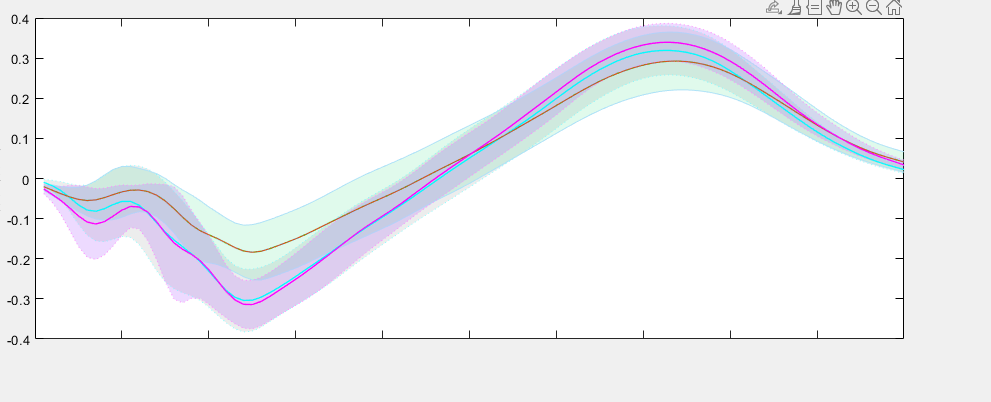matlab绘制阴影误差带函数
matlab误差带函数绘制效果

函数的input:(x,y,errBar,varargin)
%x:自变量x轴数据
%y:数据矩阵y
%errBar一般取y数据的均值和标准差,errBar可以是由两个函数句柄组成的cellArray。这个第一个定义了行应该是的统计信息,第二个定义了定义错误栏
调用语句shadedErrorBar(x, y, {@mean,@std}, 'lineprops', '-r');
function varargout=shadedErrorBar(x,y,errBar,varargin)
% generate continuous error bar area around a line plot
% function H=shadedErrorBar(x,y,errBar, ...)
% Purpose
% Makes a 2-d line plot with a pretty shaded error bar made
% using patch. Error bar color is chosen automatically.
% Inputs (required)
% x - vector of x values [optional, can be left empty]
% y - vector of y values or a matrix of n observations by m cases
% where m has length(x);
% errBar - if a vector we draw symmetric errorbars. If it has a size
% of [2,length(x)] then we draw asymmetric error bars with
% row 1 being the upper bar and row 2 being the lower bar
% (with respect to y -- see demo). ** alternatively **
% errBar can be a cellArray of two function handles. The
% first defines statistic the line should be and the second
% defines the error bar.
% Inputs (optional, param/value pairs)
% 'lineProps' - ['-k' by default] defines the properties of
% the data line. e.g.:
% 'or-', or {'-or','markerfacecolor',[1,0.2,0.2]}
% 'transparent' - [true by default] if true, the shaded error
% bar is made transparent. However, for a transparent
% vector image you will need to save as PDF, not EPS,
% and set the figure renderer to "painters". An EPS
% will only be transparent if you set the renderer
% to OpenGL, however this makes a raster image.
% 'patchSaturation'- [0.2 by default] The saturation of the patch color.
% Outputs
% H - a structure of handles to the generated plot objects.
% Examples:
% y=randn(30,80);
% x=1:size(y,2);
% 1)
% shadedErrorBar(x,mean(y,1),std(y),'lineprops','g');
% 2)
% shadedErrorBar(x,y,{@median,@std},'lineprops',{'r-o','markerfacecolor','r'});
%
% 3)
% shadedErrorBar([],y,{@median,@(x) std(x)*1.96},'lineprops',{'r-o','markerfacecolor','k'});
% 4)
% Overlay two transparent lines:
% clf
% y=randn(30,80)*10;
% x=(1:size(y,2))-40;
% shadedErrorBar(x,y,{@mean,@std},'lineprops','-r','transparent',1);
% hold on
% y=ones(30,1)*x; y=y+0.06*y.^2+randn(size(y))*10;
% shadedErrorBar(x,y,{@mean,@std},'lineprops','-b','transparent',1);
% hold off
%
%
% Rob Campbell - November 2009
%%%%%%%%%%%%%%%%%%%%%%%%%%%%%%%%%%%%%%%%%%%%%%%%%%%%%%%%%%%%%
% Parse input arguments
narginchk(3,inf)
params = inputParser;
params.CaseSensitive = false;
params.addParameter('lineProps', '-k', @(x) ischar(x) | iscell(x));
params.addParameter('transparent', true, @(x) islogical(x) || x==0 || x==1);
params.addParameter('patchSaturation', 0.2, @(x) isnumeric(x) && x>=0 && x<=1);
params.parse(varargin{:});
%Extract values from the inputParser
lineProps = params.Results.lineProps;
transparent = params.Results.transparent;
patchSaturation = params.Results.patchSaturation;
if ~iscell(lineProps), lineProps={lineProps}; end
%Process y using function handles if needed to make the error bar dynamically
if iscell(errBar)
fun1=errBar{1};
fun2=errBar{2};
errBar=fun2(y);
y=fun1(y);
else
y=y(:).';
end
if isempty(x)
x=1:length(y);
else
x=x(:).';
end
%Make upper and lower error bars if only one was specified
if length(errBar)==length(errBar(:))
errBar=repmat(errBar(:)',2,1);
else
s=size(errBar);
f=find(s==2);
if isempty(f), error('errBar has the wrong size'), end
if f==2, errBar=errBar'; end
end
if length(x) ~= length(errBar)
error('length(x) must equal length(errBar)')
end
%Log the hold status so we don't change
initialHoldStatus=ishold;
if ~initialHoldStatus, hold on, end
H = makePlot(x,y,errBar,lineProps,transparent,patchSaturation);
if ~initialHoldStatus, hold off, end
if nargout==1
varargout{1}=H;
end
function H = makePlot(x,y,errBar,lineProps,transparent,patchSaturation)
%%%%%%%%%%%%%%%%%%%%%%%%%%%%%%%%%%%%%%%%%%%%%%%%%%%%%%%%%%%%%
% Plot to get the parameters of the line
H.mainLine=plot(x,y,lineProps{:});
% Work out the color of the shaded region and associated lines.
% Here we have the option of choosing alpha or a de-saturated
% solid colour for the patch surface.
mainLineColor=get(H.mainLine,'color');
edgeColor=mainLineColor+(1-mainLineColor)*0.55;
if transparent
faceAlpha=patchSaturation;
patchColor=mainLineColor;
else
faceAlpha=1;
patchColor=mainLineColor+(1-mainLineColor)*(1-patchSaturation);
end
%Calculate the error bars
uE=y+errBar(1,:);
lE=y-errBar(2,:);
%Add the patch error bar
%Make the patch
yP=[lE,fliplr(uE)];
xP=[x,fliplr(x)];
%remove nans otherwise patch won't work
xP(isnan(yP))=[];
yP(isnan(yP))=[];
if(isdatetime(x))
H.patch=patch(datenum(xP),yP,1);
else
H.patch=patch(xP,yP,1);
end
set(H.patch,'facecolor',patchColor, ...
'edgecolor','none', ...
'facealpha',faceAlpha)
%Make pretty edges around the patch.
H.edge(1)=plot(x,lE,'-','color',edgeColor);
H.edge(2)=plot(x,uE,'-','color',edgeColor);
uistack(H.mainLine,'top') % Bring the main line to the top



 浙公网安备 33010602011771号
浙公网安备 33010602011771号